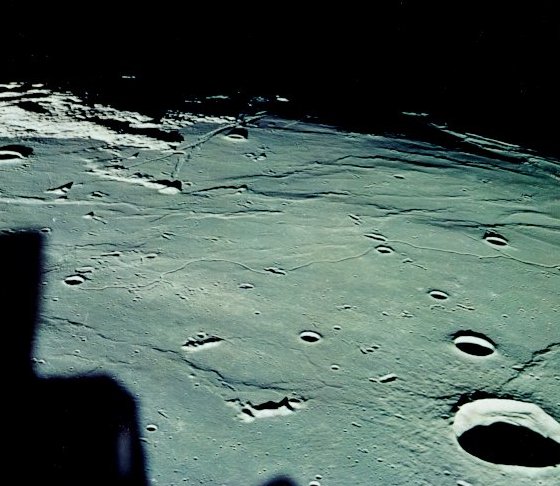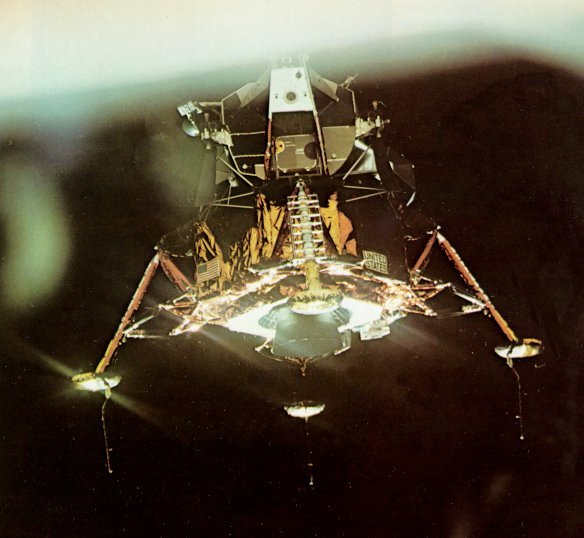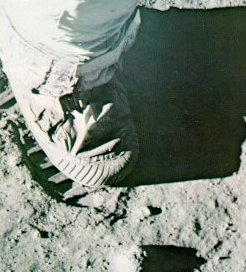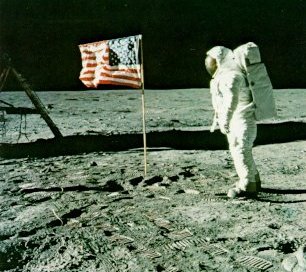
A YELLOW CAUTION LIGHT
At six thousand feet above the lunar surface a yellow caution light came on and we encountered one of the few potentially serious problems in the entire flight, a problem which might have caused us to abort, had it not been for a man on the ground who really knew his job.COLLINS: At five minutes into the burn, when I am nearly directly overhead, Eagle voices its first concern. "Program Alarm," barks Neil, "It's a 1202." What the hell is that? I don't have the alarm numbers memorized for my own computer, much less for the LM's. I jerk out my own checklist and start thumbing through it, but before I can find 1202, Houston says, "Roger, we're GO on that alarm." No problem, in other words. My checklist says 1202 is an "executive overflow," meaning simply that the computer has been called upon to do too many things at once and is forced to postpone some of them. A little farther along, at just three thousand feet above the surface, the computer flashes 1201, another overflow condition, and again the ground is superquick to respond with reassurances.

|
| The unknown that is soon to be known: This picture shows the Apollo 11 landing site one orbit before descent was begun. Tranquility Base is near the shadow line, a little to the right of center. The big jagged shape to the left is not a shadow but an out-of-focus LM thruster. |
ALDRIN: Back in Houston, not to mention on board the Eagle, hearts shot up into throats while we waited to learn what would happen. We had received two of the caution lights when Steve Bales the flight controller responsible for LM computer activity, told us to proceed, through Charlie Duke, the capsule communicator. We received three or four more warnings but kept on going. When Mike, Neil, and I were presented with Medals of Freedom by President Nixon, Steve also received one. He certainly deserved it, because without him we might not have landed.
ARMSTRONG: In the final phases of the descent after a number of program alarms, we looked at the landing area and found a very large crater. This is the area we decided we would not go into; we extended the range downrange. The exhaust dust was kicked up by the engine and this caused some concern in that it degraded our ability to determine not only our altitude in the final phases but also our translational velocities over the ground. It's quite important not to stub your toe during the final phases of touchdown.

|
| "You cats take it easy," Collins radioed in farewell as the lunar module separated - for its historic descent to the surface of the Moon. The three probes extending below the footpads were to turn on a contact light reporting when the LM was within a few feet of the surface. On the nearest landing leg note the ladder giving access to the surface from the cabin at the top. The exhaust bell of the big descent engine can be seen in the center. It made two burns, finally settling the LM gently on the surface with only seconds of fuel remaining. |
From the space-to-ground tapes:
EAGLE: 540 feet, down at 30 [feet per second] . . . down at 15 . . . 400 feet down at 9 . . . forward . . . 350 feet, down at 4 . . . 300 feet, down 3 1/2 . . . 47 forward . . . 1 1/2 down . . . 13 forward . . . 11 forward? coming down nicely . . . 200 feet, 4 1/2 down . . . 5 1/2 down . . . 5 percent . . . 75 feet . . . 6 forward . . . lights on . . . down 2 1/2 . . . 40 feet? down 2 1/2, kicking up some dust . . . 30 feet, 2 1/2 down . . . faint shadow . . . 4 forward . . . 4 forward . . . drifting to right a little . . . O.K. . . .
HOUSTON: 30 seconds [fuel remaining].
EAGLE: Contact light! O.K., engine stop . . . descent engine command override off . . .
HOUSTON: We copy you down, Eagle.
EAGLE: Houston, Tranquility Base here. The Eagle has landed!
HOUSTON: Roger, Tranquility. We copy you on the ground. You've got a bunch of guys about to turn blue. We're breathing again. Thanks a lot.
TRANQUILITY: Thank you . . . That may have seemed like a very long final phase. The auto targeting was taking us right into a football-field-sized crater, with a large number of big boulders and rocks for about one or two crater-diameters around it, and it required flying manually over the rock field to find a reasonably good area.
HOUSTON: Roger, we copy. It was beautiful from here, Tranquility. Over.
TRANQUILITY: We'll get to the details of what's around here, but it looks like a collection of just about every variety of shape, angularity, granularity, about every variety of rock you could find.
HOUSTON: Roger, Tranquility. Be advised there's lots of smiling faces in this room, and all over the world.
TRANQUILITY: There are two of them up here.
COLUMBIA: And don't forget one in the command module.
ARMSTRONG: Once [we] settled on the surface, the dust settled immediately and we had an excellent view of the area surrounding the LM. We saw a crater surface, pockmarked with craters up to 15, 20, 30 feet, and many smaller craters down to a diameter of 1 foot and, of course, the surface was very fine- grained. There were a surprising number of rocks of all sizes.

| Leaving the ninth step of the ladder, Aldrin jumps down to the Moon. Earlier on the "porch" he had radioed, "Now I want to partially close the hatch, making sure not to lock it on my way out." Armstrong's dry response was: "A good thought." On Earth his weight, including the spacesuit and mechanism-filled portable life-support system, would have totaled 360 lb; but here the gross came only to a bouncy 60 lb. The descent-engine exhaust bell (extreme right) came to rest about a foot above the surface. |
A number of experts had, prior to the flight, predicted that a good bit of difficulty might be encountered by people due to the variety of strange atmospheric and gravitational characteristics. This didn't prove to be the case and after landing we felt very comfortable in the lunar gravity. It was, in fact, in our view preferable both to weightlessness and to the Earth's gravity.
When we actually descended the ladder it was found to be very much like the lunar-gravity simulations we had performed here on Earth. No difficulty was encountered in descending the ladder. The last step was about 3 1/2 feet from the surface, and we were somewhat concerned that we might have difficulty in reentering the LM at the end of our activity period. So we practiced that before bringing the camera down.

| The dusty surface took footprints like damp sand. Although superficicilly soft, it proved remarkably resistant to penetration by coring tubes, which generally hung up after being driven a few inches. |
ALDRIN: We opened the hatch and Neil, with me as his navigator, began backing out of the tiny opening. It seemed like a small eternity before I heard Neil say, "That's one small step for man . . . one giant leap for mankind." In less than fifteen minutes I was backing awkwardly out of the hatch and onto the surface to join Neil, who, in the tradition of all tourists, had his camera ready to photograph my arrival.

| The flag of Tranquility Base was not a symbol of territorial claim so much as identification of the nation that had carried out the first manned landing. Aldrin's forward-leaning stance here was the normal resting position of an Astronaut wearing the big life-support pack. Note eroded, half-buried rock in right foreground. |
I felt buoyant and full of goose pimples when I stepped down on the surface. I immediately looked down at my feet and became intrigued with the peculiar properties of the lunar dust. If one kicks sand on a beach, it scatters in numerous directions with some grains traveling farther than others. On the Moon the dust travels exactly and precisely as it goes in various directions, and every grain of it lands nearly the same distance away.
| Next |